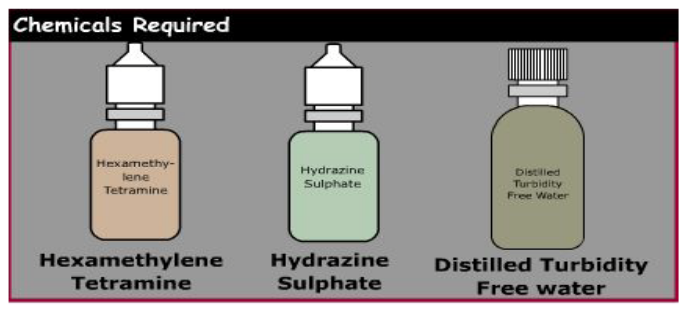EXPERIMENT ON DETERMINATION OF TURBIDITY
PREAMBLE:
Test procedure is in accordance to IS: 3025 (Part 10) - Reaffirmed 2002. In addition to our Egyption Standard, we also discuss in brief regarding the procedure
stated in
(1) APHA Standard Methods for the Examination of Water and Wastewater - 20th Edition. Method 2130 B.
(2) Methods for Chemical Analysis of Water and Wastes, EPA-600/4-79-020, USEPA,Method 180.1.
AIM
INTRODUCTION
ENVIRONMENTAL SIGNIFICANCE
The filter may go out of operation, if excess turbidity exists. Knowledge of the turbidity variation in raw water supplies is useful to determine whether a supply requires special treatment by chemical coagulation and filtration before it may be used for a public water supply. Turbidity measurements are used to determine the effectiveness of treatment produced with different chemicals and the dosages needed. Turbidity measurements help to gauge the amount of chemicals needed from day-to-day operation of water treatment works.
Measurement of turbidity in settled water prior to filtration is useful in controlling chemical dosages so as to prevent excessive loading of rapid sand filters. Turbidity measurements of the filtered water are needed to check on faulty filter operation. Turbidity measurements are useful to determine the optimum dosage of coagulants to treat domestic and industrial wastewaters. Turbidity determination is used to evaluate the performance of water treatment plants.
PRINCIPLE
MATERIALS REQUIRED
APPARATUS REQUIRED
2. Sample Cells
3. Standard flasks
4. Funnel
5. Wash Bottle
6. Tissue Papers
CHEMICALS REQUIRED
2. Hydrazine sulphate
3. Distilled water
SAMPLE HANDLING AND PRESERVATION
PRECAUTIONS
• The presence of coloured solutes causes measured turbidity values to be low. Precipitation of dissolved constituents (for example, Fe) causes measured turbidity values to be high.
• Light absorbing materials such as activated carbon in significant concentrations can cause low readings.
• The presence of floating debris and coarse sediments which settle out rapidly will give low readings. Finely divided air bubbles can cause high readings.
PROCEDURE
PREPARATION OF REAGENTS
• Weigh accurately 1 g of hydrazine sulphate and dissolve it in turbidity free distilled water.
• Take 100 mL standard measuring flask and place a funnel over it.
• Transfer it to a 100 mL standard flask and make up to 100 ml using turbidity free distilled water.
2. Hexamethylene Tetramine
• Weigh accurately 10 g of Hexamethylene tetramine and dissolve it in turbidity free distilled water.
• Take 100 mL standard measuring flask and place a funnel over it.
• Transfer it to a 100 mL standard flask and make up to 100 ml using turbidity free distilled water.
3. Standard 4000 NTU Solution
• Allow the mixture to stand for 24 hours.
• After 24 hours, make up the volume to 100 mL using turbidity free distilled water.
• The standard 4000 NTU solution is ready.
Step 1
To the sample cells, add turbidity free distilled water up to the horizontal mark, wipe gently with soft tissue. Place it in the turbidity meter such that the vertical mark in the sample cell should coincide with the mark in the turbidity meter and cover the sample cell. Now using the set zero knob, adjust the reading to zero.
Step 2
According to our need, prepare a standard solution. In this case, a 200 NTU solution is prepared by diluting the standard 4000 NTU solution and added to the sample cells, up to the horizontal mark, wipe gently with soft tissue. Place it in the turbidity meter such that the vertical mark in the sample cell should coincide with the mark in the turbidity meter and cover the sample cell. If the instrument is not showing 200 NTU, using the calibration knob adjust the reading to 200 NTU.
TESTING OF WATER SAMPLE
• Check for the reading in the turbidity meter. Wait until you get a stable reading.
• The turbidity of the given water sample is 8.4 NTU.













ليست هناك تعليقات:
إرسال تعليق